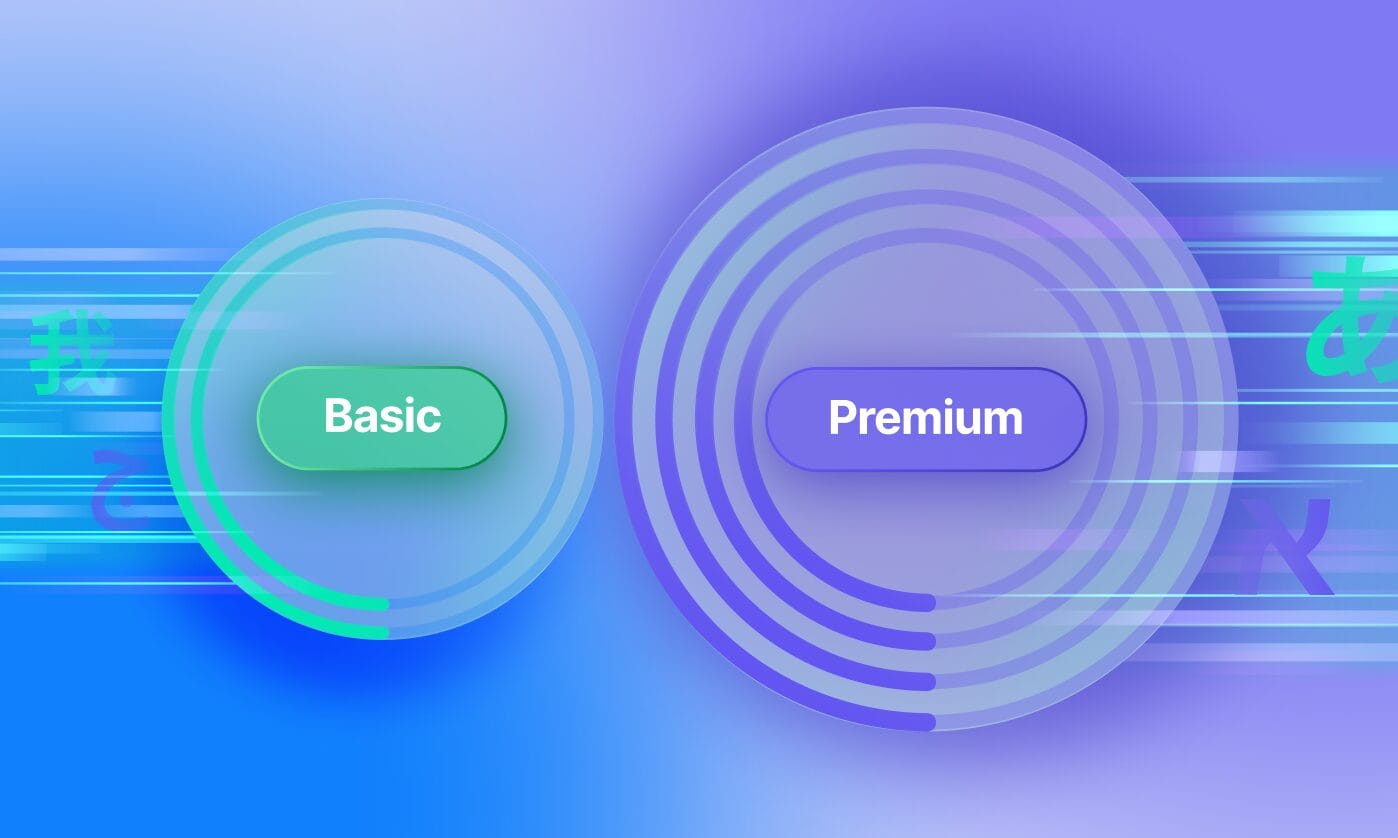Phrase Data
Instantly connect localization data with your BI dashboards
Make more of your localization data
Fine-tune your language operations with strategic insights using Phrase Data.

Align localization KPIs with company-wide BI dashboards
Make faster, data-driven decisions for your translation workflows

Implement Phrase Data with zero engineering effort

How customers use Phrase Data
Challenge
One ecommerce customer needed to track whether vendors were meeting SLA requirements for translation quality and turnaround time. They wanted a fast, visual way to spot jobs that fell short.
Solution
They combined quality and turnaround time (TAT) metrics into a single chart, visualizing translation jobs as data points that exceeded predefined thresholds. With one click, project managers could access the underlying job data, giving them immediate insight and control.

Challenge
A software company with a sophisticated localization program had been tracking data for years before migrating to Phrase TMS. They needed to maintain historical continuity and compare performance across systems despite the migration.
Solution
They combined legacy workflow data with new metrics from Phrase Data to create a unified dataset. This powers visualizations that track long-term trends, including insights from the migration period.

Challenge
Our client needed to track the reliability of hundreds of freelancers in terms of their consistent machine translation (MT) post-editing practices. They needed to quickly flag potential under-editing or over-editing.
Solution
They now visualize MT edit distance metrics and vendor volumes, so that outlier data points are easily identifiable.

Key business benefits

Export and combine data
Visualize the business impact of translated content and adjust priorities and budget allocations accordingly.

Give stakeholders access to localization data
Assign custom access rights and allow stakeholders to view data directly in your company’s BI tool.

Create company-specific metrics
Transform granular localization data into custom KPIs aligned with business goals.
Build advanced automations
Power Orchestrator workflows with Phrase Data to handle heavy queries and run advanced automations fast.

Forecast based on historical data
Use historical trends to forecast localization costs based on content volume and vendor rates.

Loop in your BI team

Integration of Phrase Data is quick—no engineering required.
Here’s some use cases and sample queries.
Phrase Data plans: find the right fit
Phrase Data is available in two tiers, designed to fit your specific business needs:
- Phrase Data Basic – Now available for Phrase customers with Team plans, this tier provides access to project and job-level localization data, enabling you to track key metrics like word count, costs, and vendor performance.
- Phrase Data Premium – Available for Phrase users with Business and Enterprise plans, Phrase Data Premium offers all of the advantages of Phrase Data Basic, with the added granularity of segment-level insight, allowing you to analyze translation quality, MT usage, and post-editing impact in even greater detail.
Both plans allow you to export localization metadata to your BI tools, combine it with company-specific data, and generate actionable insights to refine your localization strategy.

FREQUENTLY ASKED QUESTIONS
Here to field your questions about Phrase Data
Where can you export your data to?
Our business intelligence team can create a custom integration to various data warehouses. Contact your dedicated Customer Success Manager or our Sales team to discuss your specific requirements.
What is the difference between Phrase Analytics and Phrase Data?
Phrase Analytics is our internal analytics solution. Build custom charts within the Phrase interface and share them with team members. You do not need a BI team or SQL knowledge to use Phrase Analytics. Customers cannot export data from Phrase Analytics to visualize elsewhere.
Phrase Data is an enterprise service that gives customers access to their raw localization metadata. The data can be viewed in the business intelligence tool of their choice and combined with other sources of data. Customers need a dedicated Business Intelligence team with SQL knowledge for this solution.
How can I purchase Phrase Data?
Contact your dedicated Customer Success Manager or our Sales team.
How granular is the data?
Phrase Data offers two levels of granularity:
- Phrase Data Basic provides job-level insights, including word count, costs, and vendor performance.
- Phrase Data Premium includes both job-level and segment-level data, allowing deeper analysis of translation quality, MT performance, and post-editing impact.
With segment-level data, you can track and quantify time and cost savings by identifying which segments meet quality thresholds, and optimizing your localization workflows accordingly.
Is Phrase Data for you?
Phrase Data is designed for organizations that want to unlock deeper insights from their localization data.
With Phrase Data Premium, large-scale enterprises can access segment-level localization data to analyze translation quality, MT performance, and post-editing impact in fine detail.
With segment-level data, you can track and quantify time and cost savings by identifying which segments meet quality thresholds, and optimizing your localization workflows accordingly.
With Phrase Data Basic, your in-house BI team can access job-level localization data, and track key localization metrics including word count, costs, and vendor performance.
Phrase Data provides unparalleled localization insights, helping businesses optimize workflows, control costs, and improve translation quality at scale.
How frequently is the data updated and how far back does it go?
Data is updated twice a day, and includes lifetime data.
How can I access the data? Do I have to load the data somewhere (to a warehouse) or can I connect to them directly?
We will share login credentials to the users who require access to the data. You don’t have to load the data into your own warehouse unless you want to. There are three ways to access Phrase Data:
Use an ETL tool (that supports Snowflake as a source) to extract the data and load it into your preferred data warehouse (e.g., BigQuery, Redshift, etc.) if needed for broader integrations.
Connect it directly to your reporting tool of choice, that supports Snowflake as a source
Login to the managed Snowflake account provided by Phrase (or your own Snowflake instance if you have your own) and query the data via SQL.
How is security controlled?
Every user would need to set up multi-factor authentication (MFA). In the case of an automated tool reading the data from Snowflake, a public-private key pair authentication needs to be set up, with support from our Phrase technical team.
Where is the data physically hosted (which Snowflake region)?
Data is hosted within either the EU (Ireland region) or US (North Virginia region). Phrase Data will be set up based on your Phrase instance subscription.
What happens to our data if we terminate the subscription?
Upon subscription termination, Phrase Data will be handled in accordance with Phrase’s Terms of Service and applicable data protection laws. This includes the revocation of access credentials to Phrasee Data for all users in your organization. Any data previously exported (e.g. to your own systems or data warehouse) remains under your control and is not affected by Phrase’s data deletion policies.
Who can I reach out for help?
Please reach out to your dedicated Solution Architect or contact us here.
How does integrating Phrase Data with Phrase Orchestrator improve my workflows?
By connecting Phrase Data with Orchestrator, you can offload heavy or complex queries to Phrase Data instead of running them directly inside Orchestrator. This not only accelerates workflows but also ensures scalability, so your automations run quickly and reliably, even across the largest operations with thousands of translation jobs.
Examples include:
- Assigning new jobs only to linguists without overdue projects.
- Sampling data for human LQA checks across large translation volumes.
- Detecting overdue jobs and sending automated notifications to internal stakeholders.
Get started with Phrase Data
Unlock powerful localization insights with Phrase Data and drive smarter, faster translation decisions.